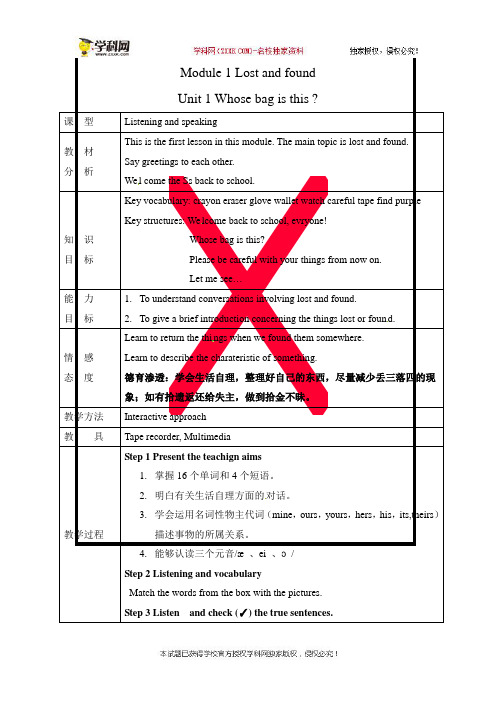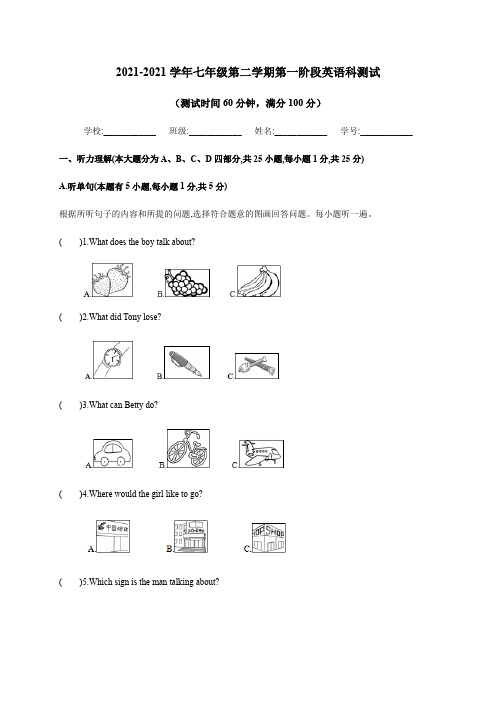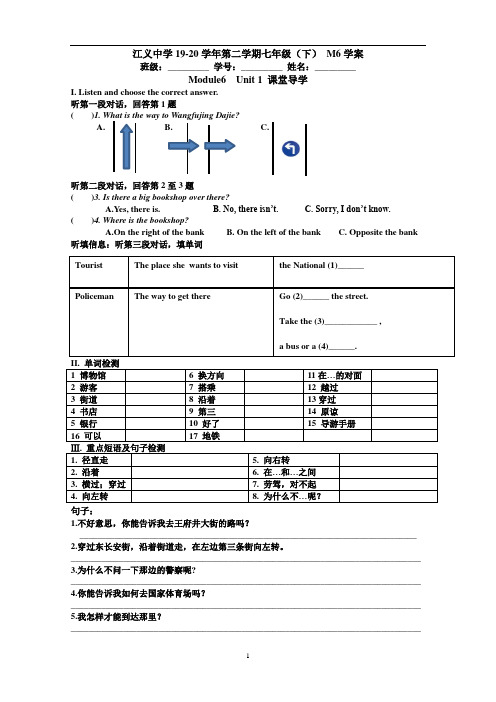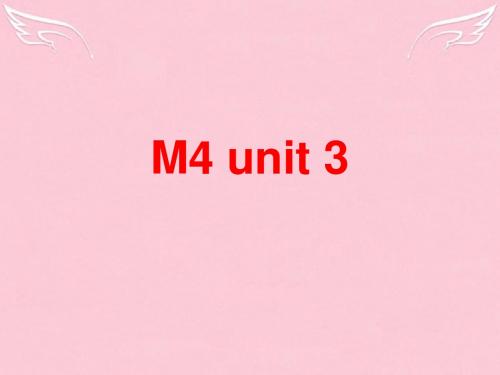广东省佛山市顺德区江义初级中学七年级英语下册《Modu
- 格式:ppt
- 大小:4.86 MB
- 文档页数:54

Module 1 Lost and foundUnit 1 Whose bag is this ? 课型Listening and speaking教材分析This is the first lesson in this module. The main topic is lost and found. Say greetings to each other.Wel come the Ss back to school.知识目标Key vocabulary: crayon eraser glove wallet watch careful tape find purple Key structures: We lcome back to school, evryone!Whose bag is this?Please be careful with your things from now on.Let me see…能力目标1.To understand conversations involving lost and found.2.To give a brief introduction concerning the things lost or foun d.情感态度Learn to return the thi ngs when we found them somewhere.Learn to describe the charateristic of something.德育渗透:学会生活自理,整理好自己的东西,尽量减少丢三落四的现象;如有拾遗返还给失主,做到拾金不昧。
教学方法Interactive approach教具Tape recorder, Multimedia教学过程Step 1 Present the teachign aims1.掌握16个单词和4个短语。
2.明白有关生活自理方面的对话。


2021-2021学年七年级第二学期第一阶段英语科测试(测试时间60分钟,满分100分)学校:____________ 班级:____________ 姓名:____________ 学号:____________一、听力理解(本大题分为A、B、C、D四部分,共25小题,每小题1分,共25分)A.听单句(本题有5小题,每小题1分,共5分)根据所听句子的内容和所提的问题,选择符合题意的图画回答问题。
每小题听一遍。
()1.What does the boy talk about?()2.What did Tony lose?()3.What can Betty do?()4.Where would the girl like to go?()5.Which sign is the man talking about?B.听对话(本题有10小题,每小题1分,共10分)根据所听内容,回答每段对话后面的问题,在每小题所给的三个选项中选出一个最佳答案。
每段对话听两遍。
听第一段对话,回答第6小题。
()6.Where does the man want to go?A.To the bookshop.B. To the restaurant.C.To the park.听第二段对话,回答第7小题。
()7.Which place are they talking about?A. A park.B.A supermarket.C.A police station.听第三段对话,回答第8小题。
()8.How will people see doctors in the future?A.They will go to hospitals.B.By using computers.C.By using phones.听第四段对话,回答第9小题。
()9.When does Betty want to have a party?A.This afternoon.B.This evening.C.Tomorrow morning.听第五段对话,回答第10小题。

江义中学19-20学年第二学期七年级(下)M6学案班级:_________ 学号:_________ 姓名:_________Module6 Unit 1 课堂导学I. Listen and choose the correct answer.听第一段对话,回答第1题( )1. What is the way to Wangfujing Dajie?A. B. C.听第二段对话,回答第2至3题( )3. Is there a big bookshop over there?A.Yes, there is.B. No, there isn’t.C. Sorry, I don’t know.( )4. Where is the bookshop?A.On the right of the bankB. On the left of the bankC. Opposite the bank 听填信息:听第三段对话,填单词II. 单词检测1 博物馆 6 换方向11在…的对面2 游客7 搭乘12 越过3 街道8 沿着13穿过4 书店9 第三14 原谅5 银行10 好了15 导游手册16 可以17 地铁1. 径直走 5. 向右转2. 沿着 6. 在…和…之间3. 横过;穿过7. 劳驾,对不起4. 向左转8. 为什么不…呢?句子:1.不好意思,你能告诉我去王府井大街的路吗?_____________________________________________________________________________ 2.穿过东长安街,沿着街道走,在左边第三条街向左转。
________________________________________________________________________________ 3.为什么不问一下那边的警察呢?________________________________________________________________________________ 4.你能告诉我如何去国家体育场吗?________________________________________________________________________________ 5.我怎样才能到达那里?________________________________________________________________________________ Tourist The place she wants to visit the National (1)______Policeman The way to get there Go (2)______ the street.Take the (3)____________ ,a bus or a (4)______.Module 6 Unit 2 课堂导学I. Read the passage and choose the correct answer.( )1. Where will we start our tour?(依据:paragraph___ line ____)A. National GalleryB. Trafalgar SquareC. Buckingham PalaceD. London Eye( )2. What will you find in the National Gallery?(依据:paragraph___ line ____)A. lots of lovely animalsB. lots of famous paintingsC. lots of interesting booksD. lots of people( )3. London Eye is _______ Big Ben.(依据:paragraph___ line ____)A.on the right ofB. on the left ofC. oppositeD. above( )4. Which sentence is wrong?(依据:paragraph___ line ____)A. Houses of Parliament are on the left of London Eye.B. It takes you 135 metres above the River Thames.C. The best way to see London is by boat.D. Go across the river, the London Eye is on your right.II. 信息归纳。


Module 8 Choosing presents一、学习目标:1.单词和短语:card, party, present, would, always, great, cake, never, special, eat, give, sing, happy, secret, CD, cinema, concert, magazine, scarf, silk, shirt, T-shirt, choose, exercise, wear, expensive, clothes, shoes, spend, money, film, song, match, weekend, at weekends, dear, hear, hear from, afraid2.交际用语:1)—Would you like to come to my birthday party?—Yes, I’d like to. When is it?2) Great!3) It’s a secret.3.重点句子:1) Daming always gets birthday presents!2) She often goes to the cinema.3) What do you usually do at a Chinese birthday party?4) We sometimes give birthday cards.5) My mother never makes a birthday cake.二、重点及难点:1.频度副词的使用及在句中的位置。
2.动词第三人称单数形式。
三、教学设计:Unit 3 Language in useⅠTeaching modelRevision and applicationⅡTeaching methodTasked-basedⅢTeaching aimsTo summarise and consolidate grammar focus.Present simple with he, she, it.Adverbs of frequency.ⅣTeaching ObjectivesKey vocabulary: dear, hear, hear from, afraidKey structures: To summarise and consolidate grammar focus. Present simple with he, she, it. Adverbs of frequency.ⅤTeaching aidsTape recorder, OHP, handoutsⅥTeaching StepsStep 1 RevisionReview the text of Unit 1 and Unit 2.Step 2 Language practice1. Read through the example sentences in the box with the whole class.2. Ask the students to repeat the sentences in the box.3. Grammar: Ad verbs of frequency.Step 3 Work in pairs1. Ask one or two students the question:— Does Grandpa always watch TV?—Yes, he does.2. Ask and answer questions about Grandpa.3. Carry on with other students until everyone understands the aim of the activity.4. Complete the table in Activity 1 for yourself.5. Work in pairs.6. Ask and answer.Step 4 Rewrite the sentences with the words in brackets.1. Review the using of often, usually, always, never.2. Ask the students to do this activity on their own, then check with a partner.3. Call back the answers from the whole class, check the answers.Keys:1. I often go to the cinema.2. He usually plays football on Saturday.3. She always gets up at 7:00.4. They never eat chocolate at home.Step 5 Complete the sentences with Would you like …or Let’s.1. Ask the students to rea d through the example sentence.2. Complete the sentences with Would you like …or Let’s….2. Call back the answers from the whole class, check the answers.Keys:1. Would you like2. Let’s3. Let’s4. Would you like5. Would you like6. Let’sStep 6 Read the emails and check (√) the true sentences.1. Ask the students to read through the emails.2. Ask the students to check (√) the true sentences3. Call back the answers from the whole class, check the answers.Keys:1. √2. ×3. √4. ×Step 7 Around the world: Birthday presents1. Ask the students to look at the picture and discuss what they can see.2. Read through the information with the whole class, and talk something about them. Step 8 Module t ask: Planning a classmate’s birthday party.A. Work in pairs. Ask and answer questions about each ot her’s birthd ay party.1. When is your birthday?2. Do you always have a birthday party?3. What do you usually do at your birthday party?B. Plan a birthday party for your partner.Choose the time and placeChoose the foodChoose what to doC. Work with the whole class. Describe your plans for your partner’s birthday par ty. Don’t say who your partner isNow guess wh o your partner is…Step 9 ExerciseA. 翻译下列句子:1.我在电视上知道这个消息。
唐海建筑改造方案唐海建筑改造方案是指对唐海建筑物进行改造、翻新或重建的方案。
唐海拥有丰富的历史文化底蕴和独特的建筑风格,建筑改造方案应该充分尊重和保护这些特点,并结合现代建筑设计理念,实现建筑物的功能优化、环境改善和历史文化的传承。
下面是一份针对唐海建筑改造的方案。
第一部分:项目背景和目标1.1 项目背景:唐海是一个具有悠久历史的城市,拥有众多历史文化遗址和古建筑群。
然而,由于年代久远以及自然和人为的破坏,部分建筑出现了老化、破损和失修的情况,无法很好地保护和展示其历史价值。
本方案旨在对这些建筑进行改造,保护和传承历史文化。
1.2 项目目标:- 保护和修复历史建筑,恢复其原貌和特色。
- 优化建筑物的功能,提高使用效率和舒适度。
- 改善建筑周围的环境,增加绿化和公共设施。
- 结合现代设计理念,实现传统与现代的融合。
第二部分:建筑改造方案2.1 建筑保护与修复:对于老化和破损的建筑,进行全面的修复工程,包括砖石的修补,木材的更换和石雕的修复。
对于无法修复的部分,进行适度的重建,以保持建筑的整体风貌。
同时,对建筑物进行结构强化,增加抗震能力。
2.2 功能优化:根据建筑物原有的用途和现阶段需求,进行功能的优化和调整。
例如,将废弃的厂房改建为文化艺术展示中心,或者将空置的民居改造为创意工作室。
通过这些功能调整,改造建筑物能够更好地适应现代社会的需求。
2.3 环境改善:优化建筑周围的环境,打造宜居的社区环境。
加强城市绿化,增加公共花园和小型公园,提供休闲和娱乐的场所。
同时改善交通组织,增加人行道和自行车道,减少车辆通行。
通过这些举措,为居民提供更好的生活环境。
2.4 传统与现代融合:在保护和修复的基础上,结合现代的建筑设计理念,使传统与现代相融合,创造出新的建筑艺术。
例如,在古老的建筑中增加现代的材料和造型,通过对比突出传统建筑的特点。
这种融合的方式可以充分展示历史建筑的价值,同时展示现代化的风貌。
第三部分:项目实施计划3.1 前期调研:对唐海的历史建筑进行全面的调研和评估,了解其现状和问题。
Unit 1 There are thirty students in my class.Teaching Aims and Demands:1. 知识目标:掌握下列重点单词和词组的意思及用法there, forty-six, computer, map, dictionary, wall, library, picture, television, right, fifteen, sixty, seventeen,eighteen, thirty, forty, fifty, sixty, seventy, eighty, ninety, many, how many, any, tree2. 能力目标:能在实际情境中运用句型:there is / there areCan introduce one’s classroom.3.情感目标:培养学生热爱学校,热爱自己家园的意识。
Teaching main points and difficult points:1.重点:There is a/ an….There are2.难点:There is a/ an….There are …的具体用法.Teaching Aids: Multi-Media (or Tape recorder, OHP)Teaching Procedures:Step 1 Leading-in1. Ss look the pictures and answer the questions.T:What school are yo u in?S:I am in No. 1 Middle School.T:What class are you in?S:I’m in Class Two.T:How many students are there in your class?S:There are 30 students in my class.Step 2 Show the learning aimsStep 3 Listen and repeat/ʌ/ some/a:/ are classroom/ə/ computer teacher/ə:/ girl thirtyStep 4 Consolidate new words1. Learn the word on your own2. Look and say.The teachers shows the pictures of new words and let the students to say as quickly as possible.3. Find and say.The teacher shows pic tures of different numbers, and the students find the right numbers.Step 5 Look and sayLook at the pictures and talk about them according to the following words.blackboard, book, classr oom, computerdesk, funiture, map, picture, television, wallStep 5 ListeningListen and choose the right pictures.20 twenty 30 thirty 40 forty 50 fifty 60 sixty70 seventy 80 eighty 90 ninetyStep 6 Pre-readingHow many desks can you see?How many students are there in the picture?......Step 7 Listen and read。